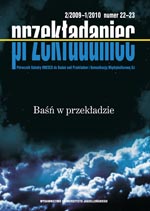Bariery literatury dla dzieci. Recepcja książek obrazkowych we Włoszech a kwestia głośnej lektury
Borders of Children’s Literature. Reception of Picture Books in Italy and the Question of Reading Aloud
Author(s): Annalisa SezziSubject(s): Language and Literature Studies
Published by: Wydawnictwo Uniwersytetu Jagiellońskiego
Keywords: picture books; children’s literature in Italy; translation; reading aloud
Summary/Abstract: The article opens with the idea of the international “republic of childhood” without geographical and political borders, as conceived by Hazard and promoted after the Second World War. According to O’Sullivan (2004, 2005), this concept of childhood, and consequently of children’s literature, is idealistic and does not address real problems connected with the process of translation. As a matter of fact, the translation of a book for children from one language into another is not as easy as it might seem: frontiers and custom-houses do exist (Bertea 2000: 94). A peculiar cas limite is represented by the reception of the picture book in Italy: introduced thanks to the pioneering work of the publishing-house Emme Edizioni and of its translators, the genre was then rejected. Italy had to wait a decade to see the same and similar picture books republished, but it is still paying the price of this initial closing of the borders, which happened even though the translators paid custom-duties and import-duties. These depended not only on the prevailing child image held by the Italian society, but also on the different image of the adult, who was going to read picture books aloud and who was ready to put on a performance for the child reader (Oittinen 2000). In particular, examples of the discrepancy between the adult and the child images of the source texts and of the target texts selected from American and English picture books and their Italian translations will be investigated.
Journal: Przekładaniec.
- Issue Year: 2009
- Issue No: 22-23
- Page Range: 226-244
- Page Count: 19
- Language: Polish

